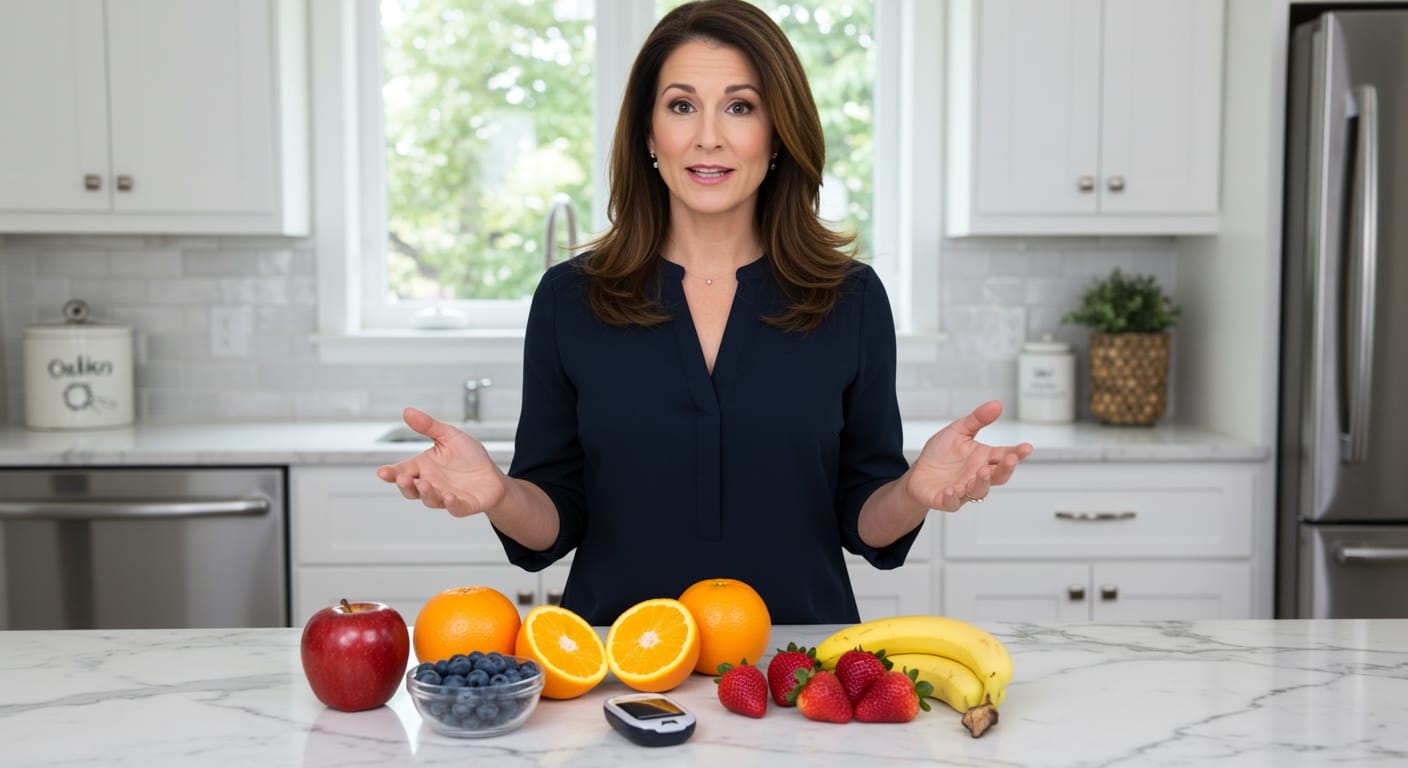✪ Key Takeaway: Diabetics can eat fruit without blood sugar spikes by choosing low-glycemic options, controlling portions, and timing consumption strategically.
Introduction
Your doctor tells you to avoid fruit because of diabetes, but your body craves the natural sweetness and nutrients.
This creates a frustrating dilemma where you feel deprived of one of nature’s most nutritious food groups while watching others enjoy colorful, delicious fruits without worry.
Hi, I’m Abdur, your nutrition coach, and today I’m going to reveal the truth about fruit consumption for diabetics and show you exactly how to enjoy fruit without dangerous blood sugar spikes.
Which Fruits Are Actually Safe for Diabetics?
The glycemic index determines how quickly fruit raises your blood sugar levels.
Berries like blueberries, strawberries, and raspberries have the lowest glycemic impact because they contain high amounts of fiber and antioxidants.
Apples and pears with their skin intact provide natural fiber that slows sugar absorption into your bloodstream.
Citrus fruits like oranges and grapefruits offer vitamin C and fiber while maintaining relatively stable blood sugar responses.
Avoid tropical fruits like pineapple, mango, and watermelon during active diabetes management because they contain higher natural sugar concentrations.
Fresh whole fruits always beat fruit juices or dried fruits because processing removes beneficial fiber and concentrates sugars.
✪ Pro Tip: Always eat fruit with the skin when possible to maximize fiber intake and slow sugar absorption.
How Much Fruit Can Diabetics Eat Safely?
Portion control makes the difference between safe fruit consumption and dangerous blood sugar spikes.
One small apple, half a cup of berries, or one medium orange represents an appropriate single serving for most diabetics.
Your individual carbohydrate tolerance determines your exact fruit portions, which varies based on medication, activity level, and current blood sugar control.
Spreading fruit consumption throughout the day prevents overwhelming your system with too much natural sugar at once.
Monitor your blood glucose levels before and after eating fruit to understand your personal response patterns.
Most diabetics can safely consume 2-3 servings of low-glycemic fruits daily when properly spaced and combined with other foods.
✪ Fun Fact: Your body processes fruit sugars differently when combined with protein or healthy fats, creating more stable blood sugar responses.
When Should Diabetics Eat Fruit for Best Results?
Timing your fruit consumption strategically prevents blood sugar spikes and maximizes nutritional benefits.
Eating fruit with meals slows sugar absorption because other macronutrients create a buffering effect in your digestive system.
Morning consumption works well for most diabetics because your body has better insulin sensitivity after overnight fasting.
Avoid eating fruit alone as snacks because this creates rapid sugar absorption without any protective buffering effects.
Post-workout fruit consumption can actually help because your muscles actively absorb glucose for recovery without spiking blood sugar.
Evening fruit consumption should be limited because your body’s insulin sensitivity naturally decreases throughout the day.
Pairing fruit with protein sources like Greek yogurt or nuts creates the most stable blood sugar response possible.
✪ Note: Never eat fruit on an empty stomach if you have diabetes, as this creates the fastest and highest blood sugar spikes.
What Makes Some Fruits Worse Than Others?
The fiber content and natural sugar composition determine how dramatically different fruits affect your blood glucose levels.
Fruits with higher fiber ratios slow digestion and create gradual sugar release instead of rapid spikes.
Fructose and glucose ratios vary significantly between fruits, with some containing more problematic sugar combinations for diabetics.
Water content dilutes natural sugars in fruits like berries and citrus, making them safer choices for blood sugar management.
Processed fruits lose their protective fiber and concentrate sugars, creating products that behave more like candy than whole food.
Ripeness levels affect sugar content dramatically, with overripe fruits containing significantly higher glucose concentrations.
Dried fruits concentrate sugars by removing water, making them particularly dangerous for diabetics despite their healthy reputation.
✪ Pro Tip: Choose slightly underripe fruits when possible, as they contain less concentrated sugars and more beneficial resistant starch.
The Bottom Line
Diabetics can absolutely enjoy fruit without blood sugar spikes by choosing low-glycemic options, controlling portions, and timing consumption strategically with meals or protein sources.
Remember my saying: “Smart choices beat complete avoidance every time when it comes to sustainable diabetes management.”
I would love to hear about your experiences with fruit and blood sugar management, so please share your questions, success stories, or concerns in the comments below.
References
At NutritionCrown, we use quality and credible sources to ensure our content is accurate and trustworthy. Below are the sources referenced in creating this article:
- Medical News Today: Fruit and diabetes: What to know
- PubMed: Fruit consumption and risk of type 2 diabetes
- WebMD: Fruit and Diabetes
- Cleveland Clinic: Can Diabetics Eat Fruit?
- Quadram Institute: The science of how fruit affect blood sugar





